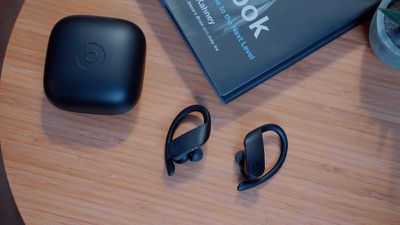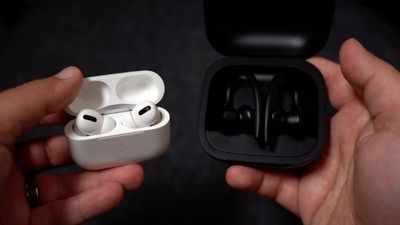Apple in late October 2019 surprised us with an upgraded version of the AirPods called the AirPods Pro, which feature Active Noise Cancellation, superior sound quality, and an all-new design.
Apple's AirPods Pro are its second set of headphones to feature the "Pro" moniker, following the Beats-branded Powerbeats Pro earbuds that Apple released back in April 2019. In this guide, we'll go over all of the differences between the AirPods Pro and the Powerbeats Pro.
AirPods Pro Design vs. PowerBeats Pro Design
The AirPods Pro are designed for casual use, while the Powerbeats Pro are aimed specifically at those who are using them for workouts like running, biking, and trips to the gym.
Design wise, the AirPods Pro look similar to the AirPods 2 but with a much shorter stem and a tweaked body design that incorporates flexible silicone ear tips, a first for the AirPods line. The silicone ear tips snap right onto the base of the AirPods Pro, allowing for a comfortable fit and Active Noise Cancellation technology.

Apple designed the silicone tips of the AirPods Pro to ensure a comfortable fit in most ears, with the design aimed at conforming to the contours of each individual ear for a superior seal.
AirPods Pro have also been designed with what Apple is calling an "innovative vent system" that's meant to equalize pressure within the ear to minimize discomfort that's common in other in-ear designs.

Apple says that AirPods Pro will make you feel like there's nothing in your ears, and in testing, we have found the AirPods Pro to be more comfortable than the Powerbeats Pro, especially over long periods of use.
The Powerbeats Pro also use silicone ear tips much like the AirPods Pro, but they're designed for fitness, also incorporating earhooks that fit over the ears to secure them in place.
Powerbeats Pro come with four tip sizes, rather than three, also offering a customized fit for each user. Powerbeats Pro are meant to stay in the ears during vigorous activity, and Apple says that it tested over 20 designs before settling on the current design that fits most people.

AirPods Pro and Powerbeats Pro both come in charging cases. The AirPods Pro charging case is larger than the charging case for the AirPods 2, but it's still quite a lot smaller than the case for the Powerbeats Pro, which is huge.

The Powerbeats Pro clamshell-style case is much larger because it has to incorporate the earhooks, which makes it almost unpocketable. The AirPods Pro case fits comfortably in a pocket.
Active Noise Cancellation
One of the key features of the AirPods Pro is Active Noise Cancellation (ANC), and this marks the first time that Apple has built ANC technology into earbuds. The feature has been previously used in over-ear Beats headphones, but not earbuds, including the Powerbeats Pro.
The Powerbeats Pro have silicone ear tips and offer noise isolation properties, but noise isolation is nowhere near as powerful as Active Noise Cancellation.

ANC uses two microphones and Apple's software algorithms to adapt sound to each user's ears. One microphone is outward-facing and designed to detect external sound to let the AirPods Pro analyze and cancel out environmental noise, while a second inward-facing microphone listens to sounds towards the ear to fine tune the noise cancellation.
AirPods Pro with Active Noise Cancellation can drown out a lot more sound than the Powerbeats Pro with simple noise isolation.
AirPods Pro also have a Transparency mode that's designed to tweak the Active Noise Cancellation algorithms so that you can continue to hear what's going on around you, useful for situations like commuting, listening for traffic, and more.
There is no Powerbeats Pro feature for filtering in ambient noises, which is something to be aware of as the Powerbeats Pro can drown out exterior sound with the volume turned up high enough.
Sound Differences
When announcing the Powerbeats Pro, Apple said that sound was a focus. The Powerbeats Pro are designed to offer powerful, balanced audio with pure sound reproduction, enhanced clarity, and improved dynamic range.

Superior sound is also a selling point of the AirPods Pro, and the AirPods Pro have an Adaptive EQ feature.
Adaptive EQ tunes the low- and mid-frequencies of music that's playing to the shape of each person's ear for what Apple says is a rich and immersive listening experience.

The AirPods Pro feature a custom high dynamic range amplifier to produce pure, clear sound, along with a custom high-excursion low-distortion speaker driver that optimizes audio quality and removes background noise.
In our testing, we didn't find a significant difference in sound quality between the Powerbeats Pro and the AirPods Pro, as both offer sound that's quite good. The Powerbeats Pro are a bit warmer and slightly more bass heavy whereas the AirPods Pro sound more neutral to our ears.
AirPods Pro have less bass, but the sound profile allows all of the instruments to be heard clearly and distinctly.
Physical Buttons
The AirPods Pro feature a Force Sensor on the stem, a control method that's unique compared to the Powerbeats Pro and the AirPods 2.

The Force Sensor supports press-based gestures, so you can press once to play or pause music, press twice to skip forward on a track, press three times to skip backwards, or press and hold to switch between Active Noise Cancellation and Transparency mode.

The Powerbeats Pro are quite a bit larger than the AirPods Pro and thus have the space for physical buttons. There are buttons for adjusting volume, changing the song track, and accepting or declining an incoming call.
The AirPods Pro have no on-device option for adjusting the volume, and that's something that needs to be done using a connected device.
Water Resistance
AirPods Pro and Powerbeats Pro both feature IPX4 water resistance, which means they can hold up to water splashing against the enclosure from any direction, but can still fail when immersed in water.
With an IPX4 water resistance rating, the AirPods Pro and the Powerbeats Pro can survive sweat exposure, but rain, swimming pools, and other excessive moisture should be avoided.
Apple's warranties do not cover water or sweat damage, which is something to be aware of.
Powerbeats Pro Colors vs. AirPods Pro Colors
Despite rumors suggesting the AirPods Pro would come in multiple colors, Apple only released them in white.

Powerbeats Pro come in Black, Ivory (an off white shade), Navy, and Moss (an olive green). AirPods Pro also feature a white charging case while all Powerbeats Pro models ship with a black charging case.
Price Difference
Powerbeats Pro are priced at $249, as are AirPods Pro, but you can often find deals that drop the price of the Powerbeats Pro by $50.
Processor, Sensors, and Siri Support
AirPods Pro and Powerbeats Pro both use Apple's H1 chip, offering simple setup, fast switching between devices, low latency, and hands-free "Hey Siri" support.

Powerbeats Pro and AirPods Pro have all of the same sensors and features that come with the H1 chip, including ear detection that plays/pauses music appropriately based on position.

The H1 chip in the AirPods Pro has a unique design because it was engineered to be in the shape of the AirPods Pro earbud, with the design dictating the internal component arrangement instead of the other way around.
Phone Calls
AirPods Pro feature a speech-detecting accelerometer and beamforming microphones designed to filter out noise when you're making a phone call or a Siri request, and Powerbeats Pro also have a similar feature.
Both earbuds have dual beamforming microphones, with the microphones in the Powerbeats Pro positioned on each side to make up for the lack of a stem like the AirPods Pro have.
Calls on both the AirPods Pro and Powerbeats Pro are crisp, clear, and sound great with little difference between them.
Battery Life
Battery life is the main area where the Powerbeats Pro have a significant edge over the AirPods Pro.
Each Powerbeats Pro earbud offers nine hours of listening time, a full four and a half hours longer than the AirPods Pro promise.
AirPods Pro offer 4.5 hours of battery life when Active Noise Cancellation is turned on, or five hours of battery life when it's turned off.
Both the AirPods Pro and the Powerbeats Pro have battery cases that extend battery life to over 24 hours, but you can get much longer listening time with the Powerbeats Pro.
Live Listen
Powerbeats Pro and AirPods Pro both support the Live Listen feature for using the earbuds as a directional microphone.
Charging
The AirPods Pro and the AirPods Pro Wireless Charging Case can be charged using the included USB-C to Lightning cable or a Qi-based wireless charger.

The Powerbeats Pro case does not support Qi-based wireless charging and must be charged with a Lightning cable.
The Powerbeats Pro have a Fast Fuel feature that adds 1.5 hours of music playback after five minutes of charging and 4.5 hours of playback after 15 minutes of charging.
The AirPods Pro also have a fast charging feature that offers around an hour of listening or talk time after charging for five minutes.
Comparison Chart
Here's an at-a-glance comparison chart that gives a quick overview of the differences between the AirPods Pro and the Powerbeats Pro.

Bottom Line
With the same $249 price point, the AirPods Pro are superior to the Powerbeats Pro because of the Active Noise Cancellation feature.
For casual, everyday use, the AirPods Pro edge out the Powerbeats Pro, but for athletes and those who need the secure fit of earhooks and the much longer battery life, the Powerbeats Pro win out.
Fit is subjective, so some people may prefer the fit of the Powerbeats Pro over the AirPods Pro or may not care about Active Noise Cancellation.
The AirPods Pro are smaller and more convenient to carry and offer wireless charging, while the Powerbeats Pro come in more colors.
Choosing between AirPods Pro and Powerbeats Pro will ultimately come down to the fit that you prefer and the set of features that you want.
More Info
For more details on the Powerbeats Pro, make sure to check out our full Powerbeats Pro guide, and for more info on the AirPods Pro, make sure to check out our AirPods Pro roundup.
We also have a comparison between the AirPods and AirPods Pro and the Powerbeats Pro and AirPods.
Guide Feedback
Have questions about AirPods Pro or Powerbeats Pro or want to offer feedback on this guide? Send us an email here.






















